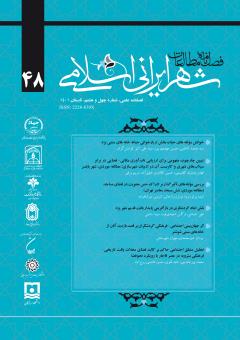نقش ابعاد گردشگری در بازآفرینی پایدار بافت قدیم شهر یزد
محورهای موضوعی : بافت تاریخی شهرهای تاریخی ایران
علی شماعی
1
,
نرگس احمدي فرد
2
![]() ,
سيما دائمي
3
,
سيما دائمي
3
1 - دانشيار گروه جغرافيا، دانشگاه خوارزمي، تهران، ايران
2 - مدرس گروه شهرسازي، واحد علوم¬و تحقيقات، دانشگاه آزاد اسلامي، تهران، ايران
3 - دكتري جغرافيا و برنامه ريزي شهري، دانشگاه خوارزمي، تهران، ايران
کلید واژه: گردشگری, بازآفرینی پایدار شهری, بافت قدیم, شهر یزد,
چکیده مقاله :
بازآفرینی شهری رویکردی برای به روز رسانی بافت قدیم شهر، ضمن حفظ هویت و اصالت محله ای، پاسخگوی نیازهای روزمره و توسعه پایدار شهری است. یکی از راهبردهای دستیابی به اين شرايط، تحقق ابعاد گردشگری در محلات شهری است. ابعاد گردشگری پایدار از لحاظ اقتصادی، اجتماعی، کالبدی و زیست محیطی با متغیرها و شاخص های بازآفرینی همخوانی دارد. بدین منظور، پژوهش حاضر به كمك چهار متغير اصلي گردشگري به بررسي نقش ابعاد گردشگري شهري در بازآفريني بافت تاريخي شهر يزد پرداخته است. هدف تحقيق حاضر شناخت روابط متقابل ميان گردشگري شهري و بازآفريني بافت قديم شهر يزد است. نوع پژوهش کاربردی و روش آن توصيفي- تحلیلی است. جامعه آماری پژوهش، شهروندان ساکن در بافت قدیم شهر یزد با حجم نمونه 375 نفر با استفاده از فرمول کوکران و 30 نفر از متخصصان و کارشناسان شهری است. نتایج پژوهش نشان داد که توسعه گردشگری بیشترین نقش را در شاخص های بعد کالبدی و اقتصادی دارد. همچنین گردشگری شهری در ایجاد امکانات فرهنگی، مراکز تفریحی، ورزشی، افزایش روابط اجتماعی، مبادلات فرهنگی، تقویت هویت فرهنگی شهر، توسعه فعالیتهای خدماتی، جلوگیری از رکود اقتصادی نقش داشته است. نتایج بهدستآمده از تحلیل SOAR نشان داد که مهم ترین نقش گردشگری، توسعه ابعاد اجتماعی و مشارکت مردمی بافت قدیم شهر در برنامه ها و طرح های گردشگری و بازآفرینی شهری و ایجاد مکان های مناسب دید و بازدید برای جذب و ماندگاری بیشتر گردشگران است.
Regeneration for updating the old textures In addition to meeting the needs of the people and daily life has a meaningful reference to the identity of the old textures, which can be achieved only in the group of attention to the dimensions of tourism in all fields. The dimensions of sustainable tourism from the economic, social, physical and environmental aspects are consistent with the dimensions and indicators of regeneration. For this purpose, the intended research has used these four approaches to investigate the dimensions of urban tourism in recreating the historical context of the studied city. Our type of research is practical and its method is exploratory-analytical. The statistical population of the research is citizens living in the old context of Yazd city with a sample size of 274 people using Cochran's formula and 30 urban specialists and experts. The results of the research showed that the development of tourism has played the biggest role in the indicators of the physical and economic dimensions. Also, urban tourism has played a role in creating cultural facilities, entertainment and sports centers, increasing social relations, cultural exchanges, strengthening the city's cultural identity, developing service activities, and preventing economic stagnation. Also, the results obtained from the SOAR analysis showed that the most important impact of tourism is the participation of the residents in tourism and urban regeneration programs and plans and the creation of recreational places to attract and retain more tourists.
